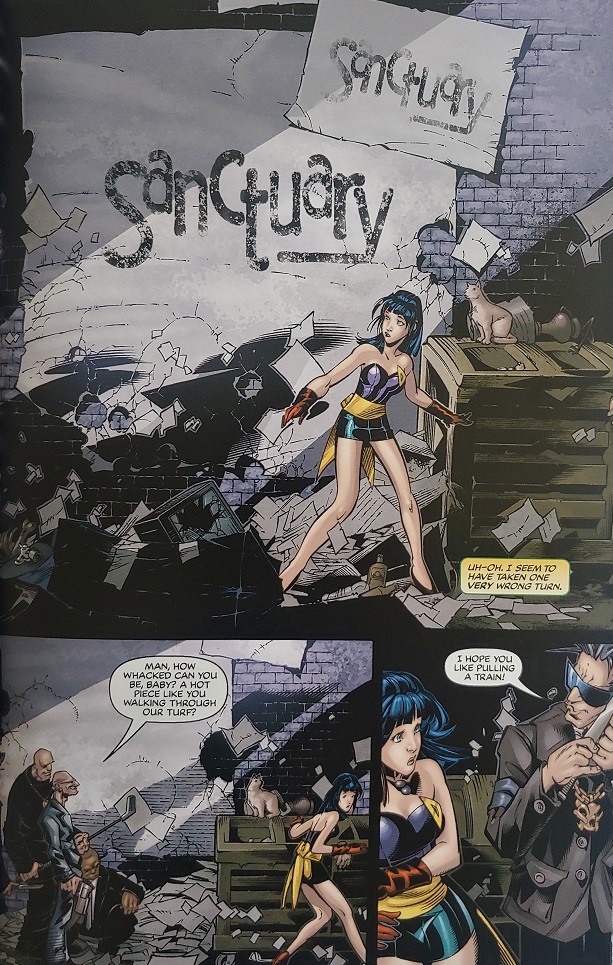Whenever I go to Bizarro World, the comic book store here in Davis, I dive into the boxes full of back issues and I have unearthed some amazing treasures. In the past year or so, nothing has been better than Common Grounds, an amazing miniseries that I didn’t even know existed... Writer Troy Hickman created a unique concept that allowed him to tell multiple, standalone stories in a single issue, while working with some of the best artists in the industry.
In “Sanctuary” (March 2004) a girl and a man meet for coffee after facing some street thugs. In their conversation we see the classic question: are superpowers a curse or a blessing? Sure, this is a question that has been asked by many superheroes but what’s really interesting here is the way in which such philosophical issue can become a very down-to-earth dialogue. This story is illustrated by Chris Bachalo, a fantastic artist who always delivers highly dynamic and lively pages. Bachalo also excels at conveying emotions, which is fundamental for the script.
The second story “Heir of Truth” is a remake of sorts, the original story was also written by Troy Hickman and illustrated by Jerry Smith, one of his colleagues. Printed in black and white and with (one might assume) a limited print run, “Heir of Truth” is one of those cases in which the story stays in the mind of the writer, and continues to evolve until it returns in a more refined version. Here, Strangeness and Charm, two superhero siblings, remember their father. Since Marvel and DC heroes aren’t too keen on reproduction, the question of different generations of heroes and the interaction between them has rarely been explored in mainstream titles. Of course, authors like Alan Moore and Kurt Busiek have written stories in which the family connections are essential. And I must say I really like Hickman’s approach, as it is concise but also moving. The siblings wonder about the true nature of their deceased father, was he a supervillain with a noble heart? Was he a good man prompted to do the wrong things at the wrong time?
 |
| Chris Bachalo |
“Heir of Truth” is illustrated by Dan Jurgens, who once again proves how talented he is when it comes to super-heroic action sequences and characters design. As I’ve mentioned before, I’ve always liked Dan Jurgens’ art when he was a regular collaborator for the Superman comics, and here he continues to be just as good as he was during his run on the Man of Steel. The striking cover, which reunites all the protagonist superheroes, is by the fantastic Rodolfo Migliari.
________________________________________________________________________________________________________
________________________________________________________________________________________________________
Cada vez que voy a Bizarro World, la tienda de cómics aquí en Davis, me sumerjo en las cajas llenas de cómics y he desenterrado algunos tesoros increíbles. En el último año, nada ha sido mejor que Common Grounds, una miniserie increíble que ni siquiera sabía que existía... El escritor Troy Hickman creó un concepto único que le permitió contar múltiples historias independientes en un sólo número, mientras trabajaba con algunos de los mejores artistas de la industria.
En “Santuario” (marzo del 2004) una muchacha y un hombre se encuentran para tomar un café después de enfrentarse a unos matones callejeros. En su conversación vemos la pregunta clásica: ¿los superpoderes son una maldición o una bendición? Claro, esta es una pregunta que se han hecho muchos superhéroes, pero lo que es realmente interesante aquí es la forma en que este tema filosófico puede convertirse en un diálogo muy realista. Esta historia está ilustrada por Chris Bachalo, un artista fantástico que siempre ofrece páginas muy dinámicas y animadas. Bachalo también sobresale en transmitir emociones, lo cual es fundamental para el guión.
 |
| Dan Jurgens |
La segunda historia “Heredero de la verdad” es una especie de remake, la historia original también fue escrita por Troy Hickman e ilustrada por Jerry Smith, uno de sus colegas. Impreso en blanco y negro y con (asumo yo) un tiraje limitadísimo, "Heredero de la verdad" es uno de esos casos en los que la historia permanece en la mente del escritor y continúa evolucionando hasta que regresa de una manera más refinada. Aquí, Strangeness y Charm, dos hermanos superhéroes, recuerdan a su padre. Dado que los héroes de Marvel y DC no están muy interesados en la reproducción, la cuestión de las diferentes generaciones de héroes y la interacción entre ellos rara vez se ha explorado en los títulos convencionales. Por supuesto, autores como Alan Moore y Kurt Busiek han escrito historias en las que las conexiones familiares son fundamentales. Y debo decir que me gusta mucho el enfoque de Hickman, ya que es conciso pero también conmovedor. Los hermanos se preguntan sobre la verdadera naturaleza de su padre fallecido, ¿era un supervillano con un corazón noble? ¿Fue un buen hombre impulsado a hacer las cosas incorrectas en el momento equivocado?
 |
| Dan Jurgens |
“Heredero de la verdad” está ilustrado por Dan Jurgens, quien demuestra una vez más lo talentoso que es cuando se trata de secuencias de acción superheroicas y diseño de personajes. Como mencioné antes, siempre me gustó el arte de Dan Jurgens cuando era un colaborador habitual de los cómics de Superman, y aquí sigue siendo tan bueno como lo fue durante su etapa en el Hombre de Acero. La llamativa portada, que reúne a todos los superhéroes protagonistas, es del fantástico Rodolfo Migliari.










